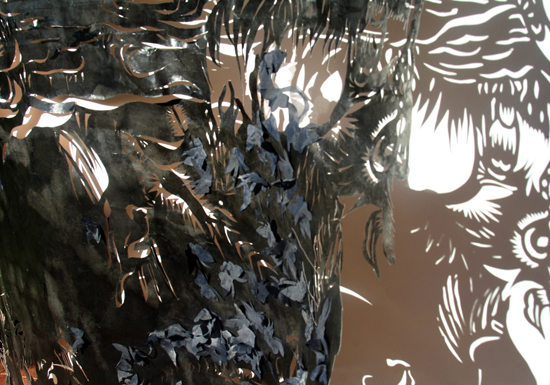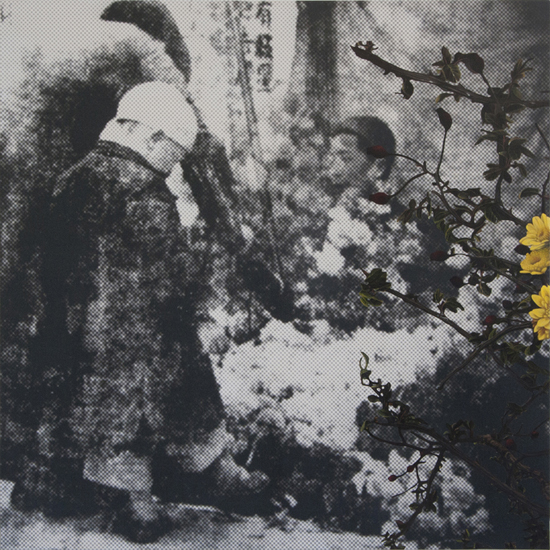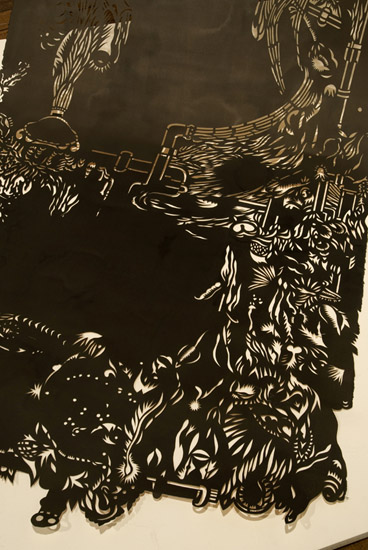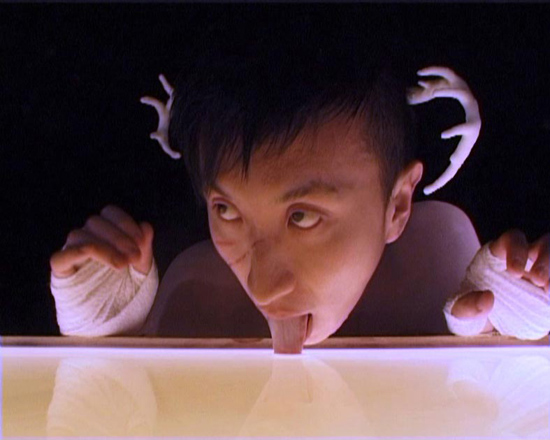Departure, displacement, dislocation, diaspora: all of these disquieting states are evident in ‘Made in China, Australia’, writes Luise Guest…
Tianli Zu, Nüwa is Pregnant, 2011. Hand cut cotton paper, Chinese tea and ink, 120cmx400cm.
Curated by Greg Leong for the Salamanca Arts Centre in Hobart and now travelling,Made in China, Australia is on show at the Lake Macquarie City Art Gallery until 28 July. The exhibition represents artists working in Australia and exploring in various ways their sense of a Chinese identity. More a liminal or imagined space than a geographic or ethnic one, the element of ‘Chinese-ness’ represented in the exhibition suggests that identities and histories are being continually reinvented and re-formed. The curator’s own story is typical in its complexity and multi-dimensionality. Leong was born in Hong Kong, but his father was born in Singapore and grew up in Malaysia. His Chinese/Australian mother was born in Cobar NSW. He studied in New York and London before moving to live and work in Tasmania. Geographic dislocations, radical shifts and changes have characterised his career in the arts – and likewise the lives and careers of many of the artists represented in the show.
Like other diaspora peoples, the Chinese have placed their imprint on the world in many surprising ways, partly due to local and global politics and partly due to the restless seeking of opportunity. The art world contains many such stories of exile and complex to-ing and fro-ing across the fault lines of history. Narratives of desire and displacement can be traced back to the early 20th century, when artists such as San Yu travelled to Paris in 1921, part of a group of Chinese artists, writers and students (including Ai Wei Wei’s poet father, Ai Qing) who went to Europe in order to immerse themselves in the exhilarating tidal wave of modernity.
The more recent diaspora following the crushing of the pro-democracy movement in 1989 is better known, particularly here in Australia where artists such as Guan Wei, Shen Jiawei, Ah Xian and Liu Xiao Xian settled and reinvented themselves. Others, including luminaries such as Huang Yong Ping, went to Paris. Still others created new lives and practices in New York, including Xu Bing and Gu Wenda. Artists such as these have of necessity created a somewhat hybrid life and identity, moving back and forth between China and Sydney, Paris, London or New York, and there is inevitably a question over the ‘Chinese-ness’ or otherwise of their work. Often the Chinese historical and cultural references are stronger in the work of these artists than they are in the work of artists who have never left the Peoples Republic. The sense of loss felt by the exile pervades their work.
Similarly, the artists included in ‘Made in China, Australia’, whether born in Australia, China, Singapore, Malaysia, Hong Kong or elsewhere are reflecting on complex multi-layered cultural identities and personal histories, as well as their relationship to Australia and that contested territory of ‘Australian-ness’ as well as the overt or subtle layers of ‘Chinese-ness’ that connects them to each other and to the motherland. The exhibition surveys the work of sixteen Australian Chinese artists extending over two generations.
John Young, Flower Market (Nanjing 1936) #3, 2010. Digital print and oil on linen, 160x160cm. Courtesy Anna Schwartz Gallery Melbourne.
Liu Xiao Xian’s work ‘Home – London’ combines old and new identities, against the new realities of the globalised world. In a large photograph, part of a series of images, a Chinese family is posed in front of a painted backdrop of the Gate of Heavenly Peace in Tiananmen Square, the portrait of Mao just visible behind the shoulder of the father. In reality, though, they are standing in front of Buckingham Palace, with mounted red-coated guards in the background. Or are they? Actually the London scene was created in Photoshop. Art historian Claire Roberts has said that the family group in the photograph is Liu’s and that the photograph was actually taken in Tiananmen Square. Thus the image, which initially appears to be a simple holiday snapshot blown up to art museum size, plays with the newly blurred boundaries between real and faked, past and present. The artist asks ‘What is real?’ and ‘Where is home?’ evoking the uncertainty of the migrant and the experience of longing for the familiarity of home.
Lindy Lee is represented by two works from an earlier phase of her practice, ‘Sagacious Liu’ and ‘Aunty’ from 2001, and by ‘One Nien Sees Eternity’ from 2009, a work which reveals her ongoing experimentation with the effects of fire and water on paper. Lee has said that it is matter, rather than image, which is important in her practice. Her early choice to photocopy masterworks from the western canon related to her sense that it was the carbon in the copy that contained her intended meaning. The resulting blurry images suggested a connection with the shadow identity of the hybrid being that she felt herself to be – seeing western art reproductions from the position of an outsider in a culture that was already ‘outside’ and marginal compared with the elusive ‘centres’ of Paris, New York or London. Lee spent years reproducing canonical western works through techniques of photocopying, printmaking and painting, in an investigation of what it meant to be an outsider in the “2nd degree culture” of Australia. She has said that she herself felt like a ‘bad copy’, alienated from her parents’ friends playing mahjong at the Chinese Club, and equally alien as “the only Chinese girl in school.” After ten years of this practice of appropriation – very successful years as a poster girl of postmodernity – she began to turn her eyes towards China. Through exploring her family’s history and their complex and traumatic migration story, and through her immersion in Buddhist thought and practice, she began to see that in her art practice “the materiality had to hold the essence of what I was trying to do”. Little ‘Sagacious Liu’ staring at the camera’s lens suggests the nostalgic sweetness of family photographs which often belies the bitterness of the past, and also speaks of the ephemerality of human existence.
Lee’s past practice of reproducing photographs and appropriated imagery connects with William Yang’s exploration of what it is to be a third generation non-Chinese-speaking Australian Chinese. The artist consciously claimed his long-denied Chinese heritage in his thirties and since that time has sought to explore Chinese themes. His work ‘Climbing Huang Shan’ records a 2005 pilgrimage to China to climb the sacred Yellow Mountain. The poignant photograph of Yang as a tiny child in 1947 next to his tricycle creates a personal interrogation of his own identity, in which his photographs and his performed ‘slideshows’ function as a kind of social history. The personal is indeed political in these works, whether they explore the gay subculture of 1980s Sydney or the Chinese history of NSW and Queensland country towns, or the anti-Chinese riots on the goldfields at Lambing Flat.
Tianli Zu, Nüwa is Pregnant, 2011.Hand cut cotton paper, Chinese tea and ink, 120x400cm.
Another artist who arrived in Australia after 1989, Tianli Zu works with the tradition of paper-cutting, which she reinvents and extends, often using video. In ‘Nuwa is Pregnant’ she explores the concepts of yin and yang, masculine and feminine. A long scroll of hand-cut cotton paper stained with Chinese tea and ink hangs from the ceiling, casting ethereal shadows. As a child growing up in Beijing with her grandparents during the dark years of the Cultural Revolution, her fondest memories are of her grandmother teaching her how to sew and to make papercuts and her grandfather reading her traditional stories and teaching her calligraphy. She returns often in her work to the traditions of scholarly painting and of folk arts such as paper-cutting, which provide a rich source of imagery and metaphor. In Zu’s work the shadow signifies things which are repressed or hidden, including femininity, desire, cruelty and death. She says that the act of cutting the paper is both performative and cathartic, creating something new and at the same time slicing away at all the sad and negative aspects of her past. Zu is the product of a culture in which what is hidden is sometimes more important than what is revealed. “I came with a shadow,” she has said, “and with my parents’ shadows.” In making works such as these she is confronting her own past and transforming it.
Brisbane-based Pamela Mei-Leng See also works with the traditional form of the papercut. When I visited the gallery her delicate silhouettes of sparrows and rabbits, introduced species considered invasive and problematic, were still being installed inside the glass window at the front of the exhibition space. She seeks to combine elements of her Chinese-Malaysian ancestry with an exploration of ideas relating to perceptions of Asian Australians. One work, ‘…place like home…’ depicts a colony of European house sparrows, birds introduced to Australia in the late 19th century which quickly established themselves in their new environment and displaced native species. They are now considered a pest, as they eat crops and are believed by some to spread disease. A work shown in the ‘Snake Snake Snake’ exhibition in Sydney earlier this year was even more overt in its references. Laser cut acrylic created an allegory of migration using images of ducks and geese. The title: ‘The locals were welcoming of the migrants as long as there was enough to go around.’
Aaron Seeto, perhaps known better for his work at 4A Centre for Contemporary Asian Art is represented by a 3 channel HD video ‘Fortress’ which he developed with the collaboration of his family. It presents a place which appears to be generic suburbia – banal, ordinary and maybe nostalgic. A shadowy backyard, interior spaces, and partial figures are glimpsed and then disappear. Like half remembered images from childhood they suggest the malleability of memory and perhaps also the sense of periphery that defines the experience of those outside the Australian mainstream. A little like Garry Trinh’s photographs of the abandoned skateboard parks that he remembers from his boyhood, the imagery in Seeto’s video evokes memories that are blurred, dreamlike and definitely a little disturbing. Is the ‘fortress’ protecting the family inhabiting the spaces from outside predators, or is it in fact imprisoning them within its boundaries? Perhaps the fortress is the edifice we create around us to define ‘us’ versus ‘them’ – familial, tribal. Seeto has said that he wanted to create a “meandering portrait” of people and place. In this body of work (although not shown here) Seeto has transformed and rephotographed images from his father’s photograph album using 19th century photographic processes. He questions how stories are told and retold, how memory is maintained or mutated, and how history is written.
Owen Leong’s ‘Birthmark’ series explores ideas of the mutability of identity through the creation of a hybrid body. Asian male and female subjects become a surface upon which a transformation can be wrought, their skin a canvas upon which a new hybrid identity can be written. In ‘Asvin’, ‘Budi’ and ‘Justin’, their obsidian blackened eyes defy the gaze and digitally applied markings of native moth wings disfigure – or, depending on one’s point of view, perhaps add a strange beauty – to their faces. There is a deliberate ambiguity to the moth markings. Mask-and membrane-like, they represent contradictory notions of belonging and of an alien status. Like hybrid creatures of myth and magic these elusive characters appear to be captured at some mid-point in shape shifting, sliding between one form, one identity, and another. Human versus animal, male versus female seem irrelevant binaries here. Leong is interested in the performative nature of sexuality and racial identity. Interviewed for ‘Peril’ magazine in 2010, he said, “My fascination was with human bodies and peeling away the surface, or puncturing the surface, to find out what’s inside.” Evanescent ethereal, the moths evoke ideas about the fleeting nature of life. The artist spent days in the Entomology Department of the Victorian Museum researching and photographing native moth species in order to apply these digital disguises to his subjects. He has said that the markings are like a tattoo, and the works pose some uncomfortable questions about the nature of race and ethnic identity, which may be assumed as a cloak in which one can hide, or be imposed on one by others. Leong’s digital video ‘AUTOevacution’ explores similar themes through the medium of the artist’s own body.
Owen Leong, AUTOevacuation, 2005. Digital video, 4:3, colour, silent, 4:29 minutes. Courtesy of the artist and Dianne Tanzer Gallery + Projects, Melbourne.
Other noteworthy works in the exhibition include Clara Chow’s ‘I Will Learn to Love Australia (Epitaph for Dad)’, Kevin Leong’s ‘Cultural Homing Device’, a touch screen computer application for the “culturally disorientated” and Jason Wing’s exploration of his mixed indigenous and Chinese heritage.
In these days of increasing hysteria about refugee boat arrivals on our shores, an exhibition such as this provides a welcome counterpoint, allowing us to reflect on the richness that other cultures have brought to Australia. In their very diverse practices each artist encourages us to see beyond simple stereotypes and consider questions about ‘home’ and ‘identity’ in much more complex, nuanced and interesting ways.





Kevin Leong work is more than note worthy. Same you only review the so called stars…supported by commerical galleries.